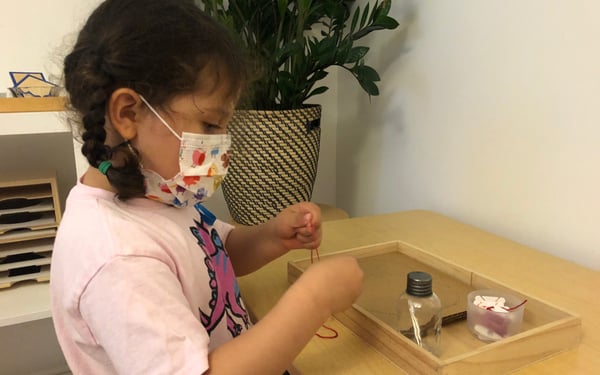 One of the main tasks the Montessori studio aims to accomplish is preparing a child’s hand for the task of writing. Writing requires a number of fine motor skills, including the strength and coordination of the thumb and first two fingers to hold the pencil securely in a ‘pincer grip’, the hand-to-eye coordination to trace visual or imagined shapes, and the flexibility of the wrist to move back and forth to allow for subtler movement in shaping letters and numbers.
One of the main tasks the Montessori studio aims to accomplish is preparing a child’s hand for the task of writing. Writing requires a number of fine motor skills, including the strength and coordination of the thumb and first two fingers to hold the pencil securely in a ‘pincer grip’, the hand-to-eye coordination to trace visual or imagined shapes, and the flexibility of the wrist to move back and forth to allow for subtler movement in shaping letters and numbers.
Many materials and activities in the classroom are designed to strengthen these fine motor skills throughout the Montessori primary cycle. Introductory Montessori materials like the knobbed cylinders and puzzles have small knobs that require a child to form a pincer grip and lift weighted objects, strengthening those fingers in the process. The Practical Life area is full of opportunities for a child in the first year of Montessori to practice using small spoons and stiff tongs to transfer small objects, which also strengthen the fingers and hand-to-eye coordination. Young learners are also tracing sandpaper letters and numbers to start to get a kinetic feel for the shapes of the letters.
As a child develops more fine motor coordination, sewing is a fun way to build flexibility and strengthen the wrists. Second year learners were excited to begin sewing with embroidery floss this week. About threading a large (and dull!) needle and following the threading holes in order, one learner remarked, “It is tricky!” Learners love to take their sewing projects home.
The metal insets are the next step in refining the pencil grip. Similar to metal stencils, the metal insets provide enough structure for a child to begin making straight and curved lines with a pencil. The metal inset exercises range from drawing a “snake” from top to bottom and back up again to making patterns and shading for more advanced learners.
Midway through their Montessori journeys, learners have developed enough dexterity that they are starting to write their names and form letters! In parallel with other writing preparatory activities, their letters and numbers become more and more legible. In the kindergarten year, learners are ready to focus on handwriting and can form letters correctly on lined paper. They continue to do advanced work with the metal insets to further strengthen their writing skills. It is an awesome process to watch!